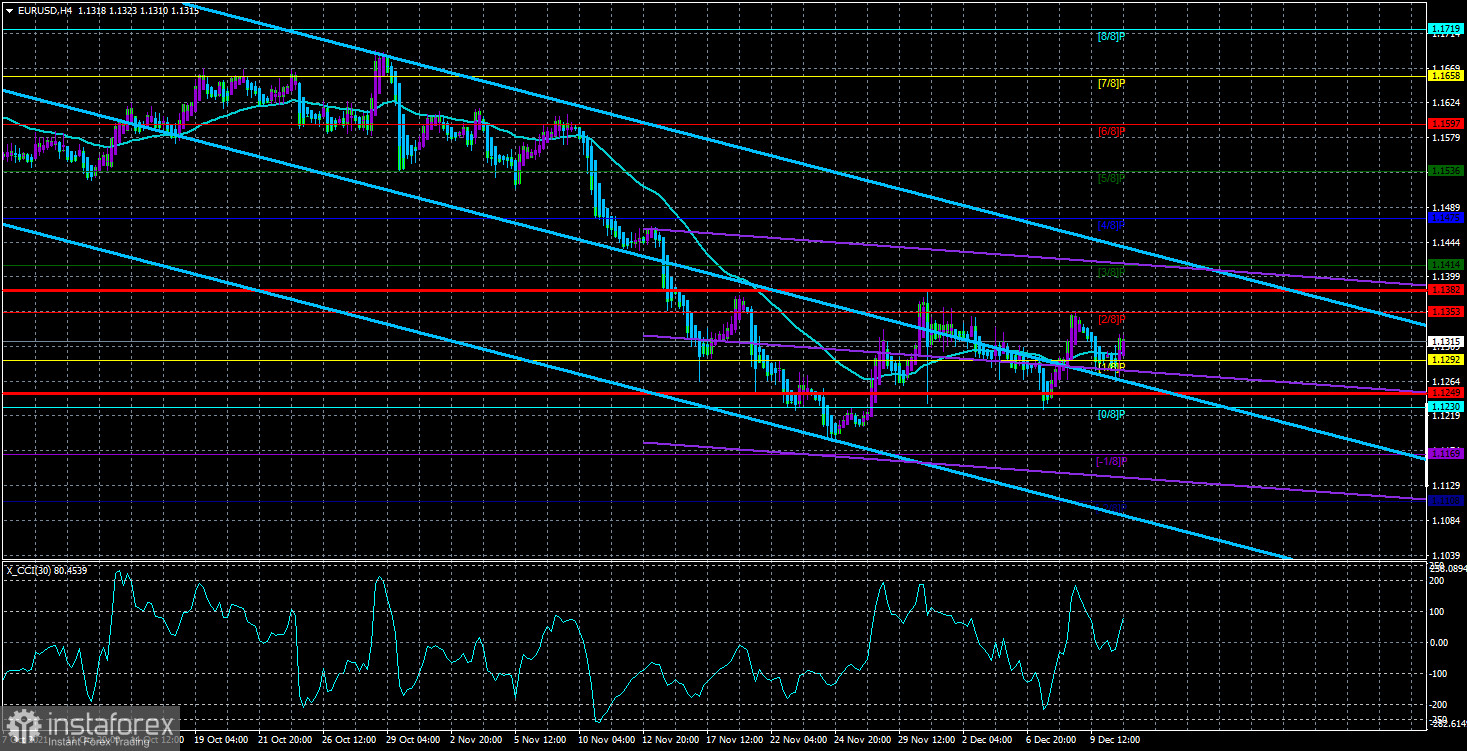4-hour timeframe

Technical details:
Higher linear regression channel: direction - downward.
Lower linear regression channel: direction - downward.
Moving average (20; smoothed) - sideways.
The EUR/USD currency pair has lost all interest in active movements in recent weeks. All price changes fit into the channel between the Murray levels "0/8" - 1.1230 and "2/8" - 1.1353. The pair is now inside the side channel. What does this mean in the current conditions? At a time when the pair has been declining for quite a long period, it would be logical to see an upward correction. However, even when there are serious technical reasons for this, the bulls refuse this scenario. At the same time, bears are in no hurry to close short positions, so the pair is not growing for this reason either. And the fact that the pair as a whole is practically not moving suggests that the markets are waiting. And they can only wait for one event. Nonfarm Payrolls and the US inflation report have already been published. Therefore, only the Fed meeting remains. In principle, there is also nothing much to wait for. We have already fully analyzed this event and traders clearly understand what can be expected from the Fed and what should not be. By and large, most experts agree that the pace of curtailing the QE program will be increased and this will be the main result of the December meeting of the regulator. There will be another press conference with Jerome Powell, at which interesting information may also be heard. In particular, about inflation, which continues to grow in the United States, by leaps and bounds. But the main thing is the decision on QE. A little below we will look at the possible movements of the pair with different solutions for QE. It should also be noted here that it will be very difficult to break the current downward trend on the 4-hour TF. At the same time, the dollar has been growing for quite a long time, so the chances of ending the "bearish" trend are growing.
What is the market reaction to expect if QE is reduced by 20-30 billion dollars?
We have already decided that the most important moment will not be the meeting itself, but the decision that the Fed will make on the QE program. Thus, if the pace of the program's curtailment is increased to 20-30 billion dollars per month, this will be a "bullish" factor for the US currency. Recall that any tightening of monetary policy is a "growth factor" for the national currency. However, at the same time, this is the foreign exchange market, and information about a possible increase in the rate of folding has been in the air for several weeks. Thus, it is likely that it is already embedded in the current dollar exchange rate. That is why the dollar may not continue to grow against the euro, even if QE is reduced in December not by 15 billion, but by 20-30. We want traders to clearly understand that sometimes markets move completely differently from what is expected of them. By the way, last Friday, the US inflation report provoked a fall in the dollar (although not strong), although earlier the acceleration of inflation in America caused its growth. We assume that the bears could have had enough and worked out all the possible factors of the fall of the euro/dollar pair. Thus, even if the QE program is reduced more than announced in November, this should not necessarily lead to a rise in the dollar. However, at the same time, increased volatility on Wednesday and Thursday is almost guaranteed. Since, in addition to the Fed meeting and its results, there will also be an ECB meeting and its results. And who knows what Christine Lagarde will tell the markets? And on Monday and Tuesday, traders can rest easy, because no important publications or fundamental events are scheduled for these days.

The volatility of the euro/dollar currency pair as of December 13 is 66 points and is characterized as "average". Thus, we expect the pair to move today between the levels of 1.1249 and 1.1382. A reversal of the Heiken Ashi indicator upwards will signal a new round of upward movement inside the side channel.
Nearest support levels:
S1 – 1.1292
S2 – 1.1230
S3 – 1.1169
Nearest resistance levels:
R1 – 1.1353
R2 – 1.1414
R3 – 1.1475
Trading recommendations:
The EUR/USD pair has consolidated back above the moving average. Thus, today you should stay in buy orders with a target of 1.1353. Sales of the pair should be considered if the price is fixed back below the moving average, with targets of 1.1249 and 1.1230. The high probability of a flat should also be taken into account. It may end this week, but it is unlikely before Wednesday and Thursday.
Explanations to the illustrations:
Linear regression channels - help determine the current trend. If both are directed in the same direction, then the trend is strong now.
Moving average line (settings 20.0, smoothed) - determines the short-term trend and the direction in which to trade now.
Murray levels - target levels for movements and corrections.
Volatility levels (red lines) - the likely price channel in which the pair will spend the next day, based on current volatility indicators.
CCI indicator - its entry into the oversold area (below -250) or into the overbought area (above +250) means that a trend reversal in the opposite direction is approaching.
 English
English 
 Русский
Русский Bahasa Indonesia
Bahasa Indonesia Bahasa Malay
Bahasa Malay ไทย
ไทย Español
Español Deutsch
Deutsch Български
Български Français
Français Tiếng Việt
Tiếng Việt 中文
中文 বাংলা
বাংলা हिन्दी
हिन्दी Čeština
Čeština Українська
Українська Română
Română

